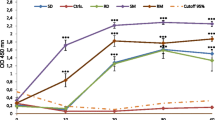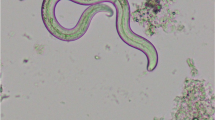Summary
Thirteen groups of rats were first sensitized with single or double doses of 5–30 third-stage larvae ofAngiostrongylus cantonensis, followed by a challenge infection with 100 larvae at various periods after the primary infection. Seven other groups of rats receiving only the sensitizing infection served as the controls. In all the sensitized rats, a significantly (p<0.05) smaller mean number of adult worms was found established in the challenge infection as compared to the control. The frequency of the sensitizing dose and timing of the challenge infection appeared to influence the intensity of the host's response. There was no conclusive evidence to indicate that the immune response could retard the growth, development, or sex ratios of the worms established in subsequent infections. A positive haemagglutinating antibody response was first observed in some rats as early as four weeks post-infection with 100 larvae when the worms began migrating from the brain to the lungs. The antibody response and eosinophilia were most pronounced during the oviposition of the female worms and hatching of firststage larvae. Changes in white blood cell, lymphocyte, and neutrophil counts were also followed in some groups.
Similar content being viewed by others
References
Basten, A., Boyer, M.H., Beeson, P.B.: Mechanism of eosinophilia. I. Factors affecting the eosinophil response of rats toTrichinella spiralis. J. Exp. Med.131, 1271–1287 (1970)
Bisseru, B.: The effect of suppressive therapy on immunity in laboratory rats and a monkey infected withAngiostrongylus cantonensis (Malayan strain). Proceedings of seminar on filariasis and immunology of parasitic infections and laboratory meetings, Singapore 1968 (1969)
Cross, J.H., Chi, C.H.: The ELISA test in the detection of antibodies to some parasitic diseases in Asia. In: The 18th Seamo-Tropmed seminar held in Kuala Lumpur, Malaysia 1977
Hayneman, D., Lim, B.L.: Prolonged survival in rats immunized by a small number of low-level doses ofAngiostrongylus cantonensis and challenged with a lethal level of infective larvae. Med. J. Malaysia20, 162–163 (1965)
Ishii, A., Kamiya, M.: Indirect fluorescent antibody test in experimental infection ofAngiostrongylus cantonensis in rats. Jpn. J. Exp. Med.43, 17–23 (1973)
Ismail, M.M., Tanner, C.E.:Trichinella spiralis. Peripheral blood, intestinal, and bone-marrow eosinophilia in rats and its relationship to the inoculating dose of larvae, antibody response and parasitism. Exp. Parasitol.31, 262–272 (1972)
Kagan, I.G., Norman, L.: Serodiagnosis of parasitic diseases. In: Manual of clinical microbiology, J.E. Blair, E.H. Lennette, J.P. Truant, eds., pp. 453–486. Bethesda, Md.: Am. Soc. Microbiol. 1970
Kamiya, M.: Haemagglutination test in rats infected withAngiostrongylus cantonensis. Southeast Asian J. Trop. Med. Public Health1, 570–571 (1970)
Kamiya, M.: An evaluation of immunodiagnosis forAngiostrongylus cantonensis infection. Mod. Media22, 363–377 (1976)
Kamiya, M., Klongkamnuankarn, K.: Immunological response of rabbits infected withAngiostrongylus cantonensis. Southeast Asian J. Trop. Med. Public Health1, 573 (1970)
Kamiya, M., Klongkamnuankarn, K., Bunnag, D.: Evaluation of haemagglutination (HA) test for the diagnosis ofAngiostrongylus cantonensis in man. (Demonstration). Southeast Asian J. Trop. Med. Public Health1, 574 (1970)
Kamiya, M., Tharavanij, S., Harinasuta, C.: Antigenicity for haemagglutinating and immunoelectrophoresis tests in fractionated antigens fromAngiostrongylus cantonensis. Southeast Asian J. Trop. Med. Public Health4, 187–194 (1973)
Lim, B.L., Heyneman, D.: Further cross-infection immunity studies of three strains ofAngiostrongylus cantonensis (Nematoda: Metastrongylidae). Proceedings of seminar on filariasis and immunology of parasitic infections and laboratory meetings, Singapore 1968 (1969)
Lowry, O.H., Rosebrough, A.C., Farr, A.L., Randall, R.J.: Protein measurement with the folin phenol reagent. J. Biol. Chem.193, 265–275 (1951)
Ottolenghi, A., Kocan, A.A., Weatherly, N.T., Larsh Jr., J.E.:Nippostrongylus brasiliensis: phospholipase in non-sensitized and sensitized rats after challenge. Exp. Parasitol.38, 96–104 (1975)
Ottolenghi, A., Weatherly, N.T., Kocan, A.A., Larsh Jr., J.E.:Angiostrongylus cantonensis: phospholipase in non-sensitized and sensitized rats after challenge. Infect. Immun.15, 13–18 (1977)
Punyagupta, S.: Eosinophilic meningoencephalitis in Thailand. Am. J. Trop. Med. Hyg.14, 370–374 (1965)
Suzuki, T., Otsuru, M., Sekikawa, H., Shiraki, T., Sato, Y., Chen, S.N., Lee, S.Y.: Studies on immunodiagnosis of angiostrongyliasis. 6. Evaluation of an intradermal test with a purified antigen. Jpn. J. Parasitol.23, 391–396 (1974)
Tungkanak, R., Sirisinha, S., Punyagupta, S.: Serum and cerebrospinal fluid in eosinophilic meningoencephalitis: Immunoglobulin and antibody toAngiostrongylus cantonensis. Am. J. Trop. Med. Hyg.21, 415–420 (1972)
Welch, J.S., Dobson, C.: Immunodiagnosis of parasitic zoonoses: comparative efficacy of three immunofluorescence tests using antigens purified by affinity chromatography. Trans. R. Soc. Trop. Med. Hyg.72, 282–288 (1978)
Yong, W.K.: Abstract of a seminar on ‘Studies on the immunity of rats toAngiostrongylus cantonensis’, based on a Ph.D. dissertation submitted to Dept. Parasitology, University of Queensland, Australia 1976
Yoshimura, K., Soulsby, E.J.L.:Angiostrongylus cantonensis: Lymphoid cell responsiveness and antibody production in rats. Am. J. Trop. Med. Hyg.25, 99–107 (1976)
Yoshimura, K., Yamagishi, T.: Immunologic response of guinea pigs to infection withAngiostrongylus cantonensis. Jpn. J. Vet. Sci.37, 585–591 (1975)
Yoshimura, K., Yamagishi, T.: Reaginic antibody productions in rabbits and rats infected withAngiostrongylus cantonensis. Jpn. J. Vet. Sci.38, 33–40 (1976)
Author information
Authors and Affiliations
Rights and permissions
About this article
Cite this article
Au, A.C.S., Ko, R.C. Changes in worm burden, haematological and serological response in rats after single and multipleAngiostrongylus cantonensis infections. Z. Parasitenkd. 58, 233–242 (1979). https://doi.org/10.1007/BF00933930
Received:
Issue Date:
DOI: https://doi.org/10.1007/BF00933930




